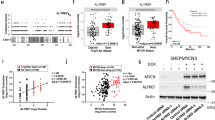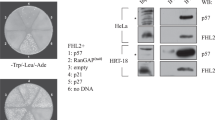Abstract
The inducible proto-oncogenic (c-Fos:c-Jun)/AP-1 transcription complex binds 12-O-tetradecanoylphorbol 13-acetate (TPA)-responsive elements (TRE) in its target genes. It is tightly controlled at multiple levels to avoid the deleterious effects of its inappropriate activation. In particular, SUMOylation represses its transactivation capacity in transient reporter assays using constitutively expressed proteins. This led to the presumption that (c-Fos:c-Jun)/AP-1 SUMOylation would be required to turn-off transcription of its target genes, as proposed for various transcription factors. Instead, thanks to the generation of an antibody specific for SUMO-modified c-Fos, we provide here direct evidence that SUMOylated c-Fos is present on a stably integrated reporter TPA-inducible promoter at the onset of transcriptional activation and colocalizes with RNA polymerase II within chromatin. Interestingly, (c-Fos:c-Jun)/AP-1 SUMOylation limits reporter gene induction, as well as the appearance of active transcription-specific histone marks on its promoter. Moreover, non-SUMOylatable mutant (c-Fos:c-Jun)/AP-1 dimers accumulate to higher levels on their target promoter, suggesting that SUMOylation might facilitate the release of (c-Fos:c-Jun)/AP-1 from promoters. Finally, activation of GADD153, an AP-1 target gene, is also associated with a rapid increase in SUMOylation at the level of its TRE and c-Fos SUMOylation dampens its induction by TPA. Taken together, our data suggest that SUMOylation could serve to buffer transcriptional activation of AP-1 target genes.
This is a preview of subscription content, access via your institution
Access options
Subscribe to this journal
Receive 50 print issues and online access
$259.00 per year
only $5.18 per issue
Buy this article
- Purchase on Springer Link
- Instant access to full article PDF
Prices may be subject to local taxes which are calculated during checkout




Similar content being viewed by others
References
Shaulian E, Karin M . AP-1 as a regulator of cell life and death. Nat Cell Biol 2002; 4: E131–E136.
Chinenov Y, Kerppola TK . Close encounters of many kinds: Fos-Jun interactions that mediate transcription regulatory specificity. Oncogene 2001; 20: 2438–2452.
Jochum W, Passegué E, Wagner EF . AP-1 in mouse development and tumorigenesis. Oncogene 2001; 20: 2401–2412.
Mechta-Grigoriou F, Gerald D, Yaniv M . The mammalian Jun proteins: redundancy and specificity. Oncogene 2001; 20: 2378–2389.
Milde-Langosch K . The Fos family of transcription factors and their role in tumourigenesis. Eur J Cancer 2005; 41: 2449–2461.
Eferl R, Wagner EF . AP-1: a double-edged sword in tumorigenesis. Nat Rev Cancer 2003; 3: 859–868.
Bossis G, Malnou CE, Farras R, Andermarcher E, Hipskind R, Rodriguez M et al. Down-regulation of c-Fos/c-Jun AP-1 dimer activity by sumoylation. Mol Cell Biol 2005; 25: 6964–6979.
Muller S, Berger M, Lehembre F, Seeler JS, Haupt Y, Dejean A . c-Jun and p53 activity is modulated by SUMO-1 modification. J Biol Chem 2000; 275: 13321–13329.
Geiss-Friedlander R, Melchior F . Concepts in sumoylation: a decade on. Nat Rev Mol Cell Biol 2007; 8: 947–956.
Barry J, Lock RB . Small ubiquitin-related modifier-1: wrestling with protein regulation. Int J Biochem Cell Biol 2011; 43: 37–40.
Bettermann K, Benesch M, Weis S, Haybaeck J . SUMOylation in carcinogenesis. Cancer Lett 2012; 316: 113–125.
Gareau JR, Lima CD . The SUMO pathway: emerging mechanisms that shape specificity, conjugation and recognition. Nat Rev Mol Cell Biol 2010; 11: 861–871.
Garcia-Dominguez M, Reyes JC . SUMO association with repressor complexes, emerging routes for transcriptional control. Biochim Biophys Acta 2009; 1789: 451–459.
Rosonina E, Duncan SM, Manley JL . SUMO functions in constitutive transcription and during activation of inducible genes in yeast. Genes Dev 2010; 24: 1242–1252.
Liu H, Zhang J, Heine GF, Arora M, Ozer HG, Onti-Srinivasan R et al. Chromatin modification by SUMO-1 stimulates the promoters of translation machinery genes. Nucl. Acids Res 2012; 40: 10172–10186.
Lyst MJ, Stancheva I . A role for SUMO modification in transcriptional repression and activation. Biochem Soc Trans 2007; 35 (Pt 6): 1389–1392.
Flühmann B, Zimmermann U, Muff R, Bilbe G, Fischer JA, Born W . Parathyroid hormone responses of cyclic AMP-, serum- and phorbol ester-responsive reporter genes in osteoblast-like UMR-106 cells. Mol Cell Endocrinol 1998; 139: 89–98.
Soderberg O, Gullberg M, Jarvius M, Ridderstrale K, Leuchowius K-J, Jarvius J et al. Direct observation of individual endogenous protein complexes in situ by proximity ligation. Nat Meth 2006; 3: 995–1000.
Bakiri L, Matsuo K, Wisniewska M, Wagner EF, Yaniv M . Promoter specificity and biological activity of tethered AP-1 dimers. Mol Cell Biol 2002; 22: 4952–4964.
Rosonina E, Duncan SM, Manley JL . Sumoylation of transcription factor Gcn4 facilitates its Srb10-mediated clearance from promoters in yeast. Genes Dev 2012; 26: 350–355.
Guo B, Panagiotaki N, Warwood S, Sharrocks AD . Dynamic modification of the ETS transcription factor PEA3 by sumoylation and p300-mediated acetylation. Nucleic Acids Res 2011; 39: 6403–6413.
Ubeda M, Vallejo M, Habener JF . CHOP Enhancement of gene transcription by interactions with Jun/Fos AP-1 complex proteins. Mol Cell Biol 1999; 19: 7589–7599.
Guyton KZ, Xu Q, Holbrook NJ . Induction of the mammalian stress response gene GADD153 by oxidative stress: role of AP-1 element. Biochem J 1996; 314 (Pt 2): 547–554.
Jakobs A, Koehnke J, Himstedt F, Funk M, Korn B, Gaestel M et al. Ubc9 fusion-directed SUMOylation (UFDS): a method to analyze function of protein SUMOylation. Nat Meth 2007; 4: 245–250.
Maison C, Bailly D, Roche D, Montes de Oca R, Probst AV, Vassias I et al. SUMOylation promotes de novo targeting of HP1α to pericentric heterochromatin. Nat Genet 2011; 43: 220–227.
Kubota Y, O’Grady P, Saito H, Takekawa M . Oncogenic Ras abrogates MEK SUMOylation that suppresses the ERK pathway and cell transformation. Nat Cell Biol 2011; 13: 282–291.
Tempé D, Piechaczyk M, Bossis G . SUMO under stress. Biochem Soc Trans 2008; 36 (Pt 5): 874–878.
Bossis G, Melchior F . Regulation of SUMOylation by reversible oxidation of SUMO conjugating enzymes. Mol Cell 2006; 21: 349–357.
Golebiowski F, Matic I, Tatham MH, Cole C, Yin Y, Nakamura A et al. System-wide changes to SUMO modifications in response to heat shock. Sci Signal 2009; 2: ra24.
Glatter T, Wepf A, Aebersold R, Gstaiger M . An integrated workflow for charting the human interaction proteome: insights into the PP2A system. Mol Syst Biol 2009; 5: 237.
Gomard T, Michaud H-A, Tempé D, Thiolon K, Pelegrin M, Piechaczyk M . An NF-κB–dependent role for JunB in the induction of proinflammatory cytokines in LPS-activated bone marrow–derived dendritic cells. PLoS ONE 2010; 5: e9585.
Harper CV, Finkenstädt B, Woodcock DJ, Friedrichsen S, Semprini S, Ashall L et al. Dynamic analysis of stochastic transcription cycles. PLoS Biol 2011; 9: 4.
Malnou CE, Brockly F, Favard C, Moquet-Torcy G, Piechaczyk M, Jariel-Encontre I . Heterodimerization with different Jun proteins controls c-Fos intranuclear dynamics and distribution. J Biol Chem 2010; 285: 6552–6562.
Acknowledgements
We are grateful to Drs R Hipskind, I Jariel-Encontre, T Salem and G Moquet-Torcy for fruitful discussions and critical reading of the manuscript. MP’s laboratory is an ‘Equipe Labellisée’ of the French Ligue Nationale contre le Cancer. This work was also supported by the CNRS, the Association pour la Recherche sur le Cancer (ARC), and the Agence Nationale de la Recherche (BLAN08-3_310119).
Author information
Authors and Affiliations
Corresponding author
Ethics declarations
Competing interests
The authors declare no conflict of interest.
Additional information
Supplementary Information accompanies the paper on the Oncogene website
Supplementary information
Rights and permissions
About this article
Cite this article
Tempé, D., Vives, E., Brockly, F. et al. SUMOylation of the inducible (c-Fos:c-Jun)/AP-1 transcription complex occurs on target promoters to limit transcriptional activation. Oncogene 33, 921–927 (2014). https://doi.org/10.1038/onc.2013.4
Received:
Revised:
Accepted:
Published:
Issue Date:
DOI: https://doi.org/10.1038/onc.2013.4
Keywords
This article is cited by
-
Diverse motif ensembles specify non-redundant DNA binding activities of AP-1 family members in macrophages
Nature Communications (2019)
-
SUMO and the robustness of cancer
Nature Reviews Cancer (2017)
-
Sumoylation coordinates the repression of inflammatory and anti-viral gene-expression programs during innate sensing
Nature Immunology (2016)
-
Sumoylation controls the timing of Tup1-mediated transcriptional deactivation
Nature Communications (2015)



